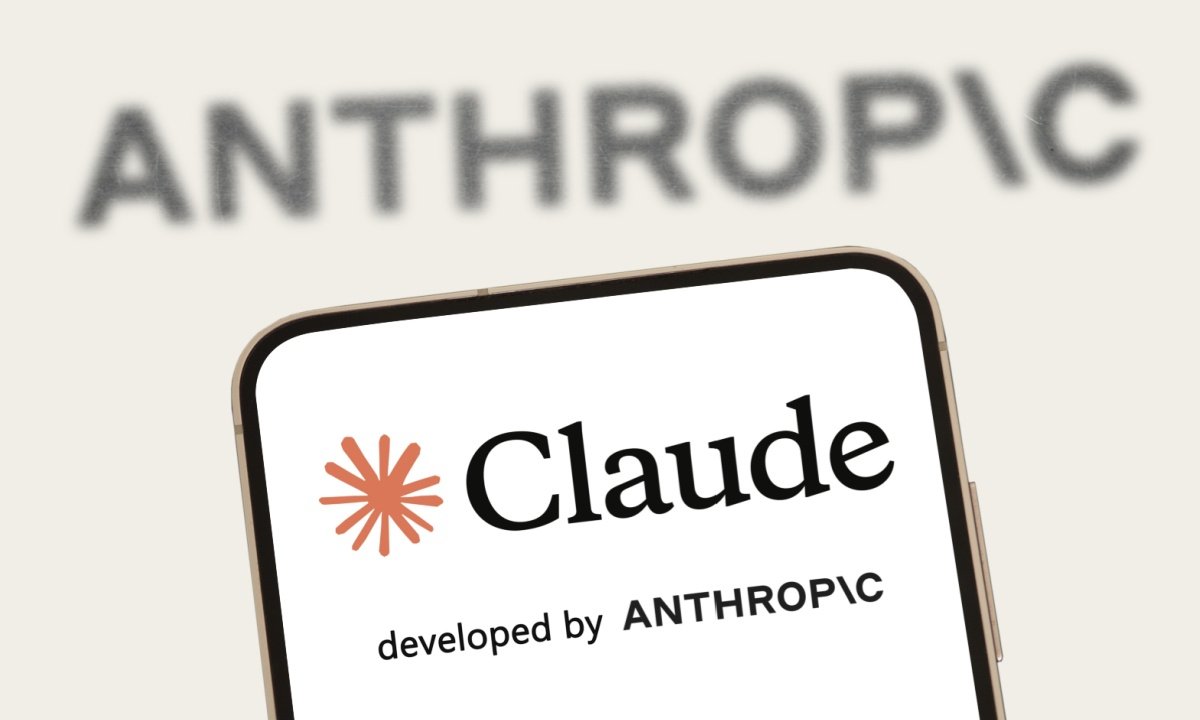AI Research
Anthropic Seeks to Raise $10 Billion Amid Strong Investor Interest

Artificial intelligence (AI) startup Anthropic is reportedly in advanced talks to raise as much as $10 billion in a new funding round.
AI Research
From postmodernism to artificial intelligence

Postmodernism can also be read as a prophecy. It denied inspiration and promoted combination. Postmodernism as a combinatorial art has brought the algorithmic model ChatGPT. This new machine surpasses even the most encyclopedic postmodern writer. Therefore, there is no point in competing with technology in the work of information. We were lucky to be the smartest on the planet. Now we must accept that AI is ahead of us
Albanian literature of Kosovo is a new literature, after the Second World War. But, it is only a branch, which is naturally linked linguistically and literaryly to Albania, as well as to the Albanian part of Montenegro and Macedonia, and of course also to the Diaspora. There have been and continue to be voices that insist that the literature of Kosovo is independent of the literature of Albania, and vice versa. So, Albanians with two states have two literatures, while the United States of America with 50 states has one literature. A provincialist voice that is not taken seriously today.
However, at a time when Kosovo and Albania were also part of the Communist Bloc, although separately, the official method of literary writing was socialist realism, but since Kosovo was included within Yugoslavia, there was greater freedom of writing, thanks to the Croatian writer Miroslav Kërlezha, who, being the president of the Writers’ League of Yugoslavia and an indisputable literary authority, managed to make the official method optional, not mandatory. So, the preferred method was socialist realism, but others were also allowed. Taking advantage of this freedom, since the 60s, in Yugoslavia we have novels like those by Danillo Kishi, “Attic”, “Psalm 44”, and later “A Grave for Boris Davidović”, “Encyclopedia of the Dead”, etc.
The most famous novel of Kosovo
In this free atmosphere for narrative experiments, the first practices of an alternative aesthetic in Kosovo also appeared. In the magazine “Jeta e Re”, from the first issue of 1972 to the first issue of 1974, stories appeared whose author was an unknown name in Kosovo: Luan Dukagjini. No one knew this name, except for the founder and publisher of the magazine, Esad Mekuli, who kept the author in complete secrecy. Only after the stories were published in the magazine and aroused a double interest: for the new storytelling model and for the unknown author, was the issue resolved, by publishing all the stories in a book with the author’s real name: Rexhep Qosja, “Death Comes to Me from Such Eyes”, thirteen stories that could make a novel. So, behind the mask of an unknown author, he was the most famous author in Kosovo, about whom critic Ali Aliu says that even his studies were read more than the prose and poetry of other Kosovar authors.
Rexhep Qosja did not hide behind the pseudonym for political reasons, but because he thought that, being already known as a professor and researcher, he would not be taken seriously in prose. This fear of moving from the academic world to the artistic world has been shared by many others, including Umberto Eco, because people who are known for works of consciousness are afraid of suddenly moving into works of the subconscious. They consider themselves more scientists than writers. So, they want to be known as knowledgeable, not as stupid.
Thus, postmodernism entered Albanian literature with great hesitation, but in a natural flow. A man who was known as a scholar, became a writer. There was no better way, when it is known that this formation has its strongest point in knowledge (information). Talent and inspiration alone are not enough to be a postmodernist. Knowledge, preferably encyclopedic, is a necessary condition. Thus, it was necessary for someone who had completed studies, had earned titles, and had accumulated knowledge, to be able to bring this poetics among us. So, it was no coincidence that this man brought this model to Kosovo and became not only the founder, but also the main representative in Albanian literature. And it is no wonder that, to this day, “Death Comes to Me Through Such Eyes” is the most translated novel from Kosovo. So, for more than half a century this is still the most famous novel from Kosovo.
In the 70s, Qosja dominated as a writer of prose and drama. In the 80s, due to the worsening situation, he returned to the role of scholar and public intellectual.
In Kosovo, the postmodernist model of the writer coming to the field of fiction from epistemological fields only re-emerged in the 90s with Kujtim Rrahmani, who had begun his career as a researcher. This trend continued into the 21st century, when researchers moved into prose: Agron Y. Gashi, Gëzim Aliu, Adil Olluri, and others.
In Albania, postmodernism was unimaginable before the 90s. Just take a look at Vath Koreshi’s essays written during the dictatorship. Meanwhile, during the 90s, new prose writers emerged who embraced the postmodern model, such as Ridvan Dibra and Agron Tufa, or even two others who came from the world of film (screenwriting): Bashkim Hoxha and Bashkim Shehu. Surprisingly, this model also attracted the author Vath Koreshi, who once publicly reviled postmodernism. There were also authors who had started out in communism, but quickly switched to the new model, such as Zija Çela and Besnik Mustafaj. This model did not even leave the most famous Albanian writer, Ismail Kadare, indifferent, who was not very concerned with fashion. Meanwhile, in Macedonia, two works appeared that can now be considered classic works of postmodernism, “The Time of Goats” (Luan Starova) and “The Years of Urith” (Kim Mehmeti).
This means that a literary model, welcomed by readers and ignored by scholars, became dominant in Albanian literature at the end of the 20th century, and continues to this day. Even the most beautiful postmodern novels were written in this century by authors such as: Ridvan Dibra, Agron Tufa, Besnik Mustafaj, Stefan Çapaliku, Durim Taçi, etc.
Heresy and the Inquisition
We must not forget that Kosovo’s literature, until the postmodern alternative was found, was written either with a simplistic and traditional realism, or with a “psychedelic modernism”, trying to graft European modernism (Proust, Joyce, Kafka, up to Alain Rob-Grillet, Nathalie Sarraute, Claude Simon) with the modernism of pre-war Albania (Koliqi, Kuteli, Fishta, Migjeni, etc.). Thus, the two best modernist authors of Kosovo, Anton Pashku and Azem Shkreli, one in prose, the other in poetry, brought ethno-modernist works, that is, a modernism with a twist. Pashku between Koliqi and Claude Simon, Azem Shkreli between Migjeni, Martin Camaj and Vasko Popa, whom he also translated. While Migjeni is a frequent reference to Shkreli, while Camaj mainly in the wisdom of the highlander, the shadow of Vasko Popa appears in his best poems. Just read them one after the other: “Instead of Greetings” (Shkreli) and “Let’s Get My Pieces Back” (Popa).
Meanwhile, Rexhep Qosjen, who was not impressed by Albanian modernism, neither the pre-war one in Albania nor the post-war one in Kosovo, as can be seen from his novel, and as he says in his diary, was particularly impressed by Danillo Kish and Kurt Vonnegut, who at that time was quite translated and well-known in Yugoslavia. In this way, the postmodern alternative was a kind of aesthetic heresy. And it was normal for the heretic to talk about persecution by the Inquisition, which monitored the intellectual like a Big Brother. Therefore, the title could also be “Death Comes to Me from the Eyes of Big Brother”.
This alternative, this heresy, was necessary for Albanian literature. It overturned literary monism (modernist, or socialist realist, it doesn’t matter) and promoted pluralism. Many writers from Kosovo, Albania and Macedonia joined this heresy, while Montenegro has the merit of bringing our first heretic. So, in a way, all the pieces of Albanian lands were united. This is a fact, however, the last thing postmodernism would like to promote is patriotism.
Although ignored by Albanian literary criticism, which was completely unprepared to follow the rapid pace of literary change, postmodernism changed the face of Albanian literature. This change was made both in terms of structuring and in the way of communication. Paradoxically, writers abandoned hermetic modernist forms, through double coding. While, for example, Pashku’s novel was barely decipherable by specialists, Dibra’s novels are understood by both types of readers: specialists and amateurs. So, while Pashku barely penetrated a type of reader who, when unable to decipher, invented the meaning, because the reader has the right to invent the meaning, in Dibra the elite reader has fun decoding the semiotic line, while the popular reader (the one who reads just to pass the time) has fun with the semantic line. Let’s not forget that Albanian literature had reached the point where it was easier to understand Proust, Kafka, Joyce, TS Eliot, Faulkner than the Kosovar modernists. On the other hand, as soon as you read any discursive writing by these people, you realized that their education was very modest. I think this only happens to poser writers, not real ones. Paul Valéry is a genius in poetry, prose and essays, even in occasional speeches. You can be a genius in something and mediocre in something else, but not a genius in prose and an idiot in essays, for example. Therefore, I suggest that when we like an Albanian poet or prose writer, we also read his essay writings, before forming an impression of him. This is not always the clearest indicator, but in most cases, it helps a lot.
So, postmodernism has great merit for the survival of the reader, who was in his last moments due to fatigue from socialist realist literature and lack of communication with modernist literature. On one side there were extremely open works, and on the other side there were hermetically closed works. Albanian postmodern authors, with alternative poetics, created two types of readers, of which the semiotic reader was often profiled as a critic. And, in this way, the author created the model reader, while the reader the model author. The postmodern author has saved, entertained, formed and emancipated the reader in general, while he has also familiarized the new reader with new techniques and notions.
Postmodernism and criticism
Until the end of the first decade of this century, one could not speak of criticism of postmodernism, but only of criticism of postmodernism. Since structuralist criticism was applied, the postmodernist paradigm was rejected. However, in the meantime, new voices of scholars emerged and master’s and doctoral theses began to be defended, and books were written on postmodern works and phenomena, consequently new approaches began to appear, with a different terminology, completely different from that which analyzed modernist texts. Many novels appeared as found manuscripts, while the author as a discoverer and commentator of them, such as, for example, Vath Koreshi with “Ulku dhe Uilli”, Rexhep Qosja with “Një dashuri dhe shtëtë faje”, or Agron Tufa with “Gurit të varrit ia rrëfej”. Also, Qosja’s prose, like that of Dibra, was distinguished by the frequent use of anaphora and enumeration. While, almost all authors played with historiographic metafiction, double coding, poioumenon, intertextual irony, collage, bricolage, pastiche, etc., and this created a postmodern condition, which displayed distrust in all metanarratives, and also included gynocentric discourse to destabilize patriarchal and androcentric discourse, in general. This category includes novels and stories by authors such as Flutura Açka, Besa Myftiu, Rita Petro and others. I would like to list many poets here, but poetry is not a representative genre in postmodernism.
In the 90s, when Albanian postmodern works flooded in, people started talking about the death of postmodernism in Europe. In 2008, Raoul Eshelman published the book “Performatism, or the End of Postmodernism”, while in 2009, Alan Kirby published the book “Digimodernism, How New Technologies Dismantle the Postmodern and Reconfigure Our Culture”. In 2010, I published a sketch of the end of postmodernism. This sketch was expanded in the meantime, and in 2017, it was published in English and in several languages and magazines, under the title “The End of the Age of Endings”, and this year it is also being published as a separate book. Usually, I am not self-referential in criticism, but I mentioned this to show that we, Albanians, have also begun to say goodbye to postmodernism, and, as they say today, we have coordinated with foreigners before going to the funeral ceremony of this formation, which remains the last ‘ism’ accepted by foreign scholars. Some scholars and artists have also proposed names for the new era, the era that comes after postmodernism: post-postmodernism, trans-postmodernism, post-millennialism, performatism, digital modernism, metamodernism, stacism, remodernism, altermodernism, hypermodernism, etc., but also other names and manifestos, related to a certain field, that contribute to, or compete with these concepts, such as: New Sincerity, New Puritanism, Dogma 95, etc. I think that the term Hysterical Realism used by James Wood, helps a lot in distancing ourselves from postmodernism. This year marks a quarter of a century since this term was first used, and authors themselves have begun to be more careful not to categorize themselves within it.
Now theorists say that postmodernism has ended, while we see that Albanian writers continue to write postmodern works. However, in the last decade we see that some authors are successfully distancing themselves from postmodernism, since in their narratives either sincerity or emotion dominates, or both. Postmodern work, in its best manifestation, was rational, rarely had emotional elements. Now the narrative has been personalized, autofiction has become dominant. So, we see a retreat of postmodernism to make way for a new current, or spirit.
It is now clear that even in Albanian literature, postmodernism is in its final stages. We are now at a time when we can divide writers into dinosaurs and chameleons. That is, into those who die as soon as their poetics are finished, and into others who adapt to new poetics, even leading to poetics that have not yet arrived. New poetics are created either by completely ignoring old poetics, or by taking from them marginal elements and turning them into central ones. The latter is happening in Albanian literature.
Results register
As proof that postmodernism has been present and successful for half a century, are the names of prominent authors and their works. One cannot ignore a formation that has brought works such as these: “Death comes to me from such eyes”, “A love and seven sins”, “The night is our day”, “Nude”, “The legend of loneliness”, “In search of the lost child”, “Sleeping on the snow”, “I tell the tombstone”, “The Chronicles of the fog”, “The time of the goats”, “The years of the urith”, “Each goes crazy in his own way”, “Born backwards”, etc. Another element that unites Albanian postmodernism is the theme of communism, treated by Qosja, Starova, Mehmeti, Dibra, Tufa, Çapaliku, Shehu, Hoxha, Açka, Petro etc. But, perhaps communism is the most generally treated theme in contemporary Albanian literature. It can be freely said that he is its main theme.
That postmodern authors have enriched Albanian literature, in many aspects (thematic, stylistic, formal, philosophical, etc.), is today indisputable. But why was postmodernism received with kicks from the departments and critics? Because one thing was not understood: that literature does not progress, but only changes. The reader gets tired of one form and seeks another. Poetics that are closed are not thrown away (not even socialist realism, which in the history of literature is the most politically instrumental); they are only conserved, turned into classics. Postmodernism, like modernism and all other isms, is not a value, but a new form of expression. Therefore, even the most postmodern works of an author do not mean that they are his best. For example, Qosje’s most postmodern work is “Nobody’s Sons”, but it is not the best (the first three novels are much better); the novels about Gjergj Elez Ali by Ridvan Dibra are the most postmodern, but not the best (“The Legend of Solitude” and “Sleep on the Snow” are much better); the novel “I Tell the Gravestone” by Agron Tufa is the most postmodern, but not the best (“Black Friday” is much better); “An Impossible Novel” by Besnik Mustafaj is the most postmodern, but not the best (many of his other novels are better), and so on. Perhaps only “Ulku dhe Uilli” is the best and most postmodern novel by Vath Koresh.
So, what criticism should have understood and then supported is the fact that poetics (models, paradigms, formations, currents) come back into fashion for a while, but this does not invalidate the old ones. It is ridiculous to think that any contemporary writer is better than Homer, Aeschylus, Dante, Shakespeare, Goethe, or Gogol. Beyond poetics, beyond forms, writers are valued for the depth of reflection, the beauty of expression, and vision. They do not simply bear witness to an event. No. They reflect on the event, tell it in a specific way, and from it derive messages for the present and the future. Poetics unites writers of a time or a place, while what separates them from each other is precisely the authenticity thanks to which they occupy an eternal place not only in literature, but in the history of civilization. As Ezra Pound says: a civilization is founded on Homer.
So, it should be clear that postmodern authors are not better than modern authors, or that today’s authors are not better than those of yesterday. Not at all. Model and value are two things. Each time has its own fashion, but when we compare beyond fashion, that is, only what is deep, philosophical, or spiritual, we cannot help but agree with the painter Marc Chagall who said: what value is the Pope’s expensive suit compared to the rags of Christ?!
We must always be aware of this.
Postmodernism and ChatGPT
Postmodernism can also be read as a prophecy. It denied inspiration and, instead, promoted combination. Almost all postmodern theorists and writers agree that literature is an ars combinatoria. So, postmodernism was the master of combining information. Towards the end of 2022, ChatGPT was invented, as a generative artificial intelligence. A few years ago, I said that the death certificate of postmodernism should include the date of Umberto Eco’s death (February 19, 2016). He was an information machine before the invention of this artificial platform. But an author who writes postmodern works after 2022 cannot be taken seriously, and even deserves to be reviled as a hysterical realist, or as Don Quixote. ChatGPT has already replaced the scribblers (requests, recommendations, descriptive articles), as well as the average writer and translator.
Postmodernism as a combinatorial art has brought this algorithmic model. Once the competition in literature was only between people, now we have a new competition, with Artificial Intelligence (AI). As for information, this new machine surpasses even the most encyclopedic postmodern writer. Therefore, it makes no sense to compete with technology in the work of information. We were lucky to be the smartest on the planet. We must now accept that AI is ahead of us, and that, as one of the CEOs said, no child born from now on will be more intelligent than Artificial Intelligence. Kazuo Ishiguro (“Klara and the Sun”, 2021) and Olga Ravn (“The Employees”, 2020) have already successfully thematized this new challenge: humans versus humanoids.
Let’s not forget that postmodernism was information. Now information has been taken over by technology. We know the challenge that awaits us, but we don’t know how we will face it as writers. In an interview towards the end of his life, Martin Heidegger said that cybernetics will replace philosophy. What artificial intelligence will do to literature is difficult to say today, but let’s ask: Will there be a second death of the author, after what Roland Barthes declared (La mort de l’auteur, 1967)? Will the book be written by AI, or by me? In what way am I better than AI? Since I have invented something that is more intelligent than me, will AI be able to invent something more intelligent than itself?
These will be the questions that will become dominant themes in tomorrow’s literature. So, for everything we ask today, we will receive the answers tomorrow. Meanwhile, since narration is an anthropological necessity, man will walk through the narrative forests of three worlds: the material world, the spiritual world, and the artificial world.
Lecture read at the International Seminar on Albanian Language, Literature and Culture, on August 27, 2025, at the Faculty of Philology, University of Prishtina. Published with permission of the author.
AI Research
Lessons from 60 Years in Journalism — A Postscript on Artificial Intelligence – TAPinto
AI Research
Building a responsible AI future in Saudi Arabia

As the world transitions from a digital age to the era of artificial intelligence (AI), key economies in the Middle East are accelerating their AI adoption plans as part of their broader economic diversification efforts. Among the GCC countries, Saudi Arabia has made bold moves to position itself as a global AI leader, writes Oliver Sykes, partner at PwC.
At the World Economic Forum (WEF) this year, Saudi Arabia reinforced its commitment to shaping global AI discourse, highlighting efforts at strengthening the digital economy and fostering innovation.
According to a recently launched report highlighting Saudi Arabia’s advancements in deep technology, 50 percent of the kingdom’s deep tech startups are already focused on developing AI and the Internet of Things (IoT), while the nation aims for AI to contribute 12 percent of its gross domestic product by 2030. Last year, the kingdom took 14th place globally and the top spot in the Arab world in the Global AI Index for 2024.
Saudi Arabia’s AI strategy includes major investments, such as a $40 billion fund to boost AI as it continues to position the kingdom as a global AI hub, with opportunities for chip makers and large-scale data centers. The country is also forging global partnerships to enhance Arabic AI models.
A catalyst for economic growth
AI is expected to be a catalyst for economic growth across multiple sectors in Saudi Arabia. Some of the most promising applications include integrating the technology into healthcare for early disease diagnosis, predictive care and pandemic prevention. AI is also being used for ride-sharing and launching autonomous vehicles, as well as for personalized financial planning, fraud detection and anti-money laundering in finance.
In energy, AI optimizes usage through smart grids, real-time monitoring and renewable integration, and it is also being harnessed to drive sustainability efforts, including carbon footprint tracking, climate change mitigation, and optimizing resource allocation in agriculture and water management.
While this potential of AI to drive value across industries is undeniable, it is equally crucial for organizations to establish robust governance frameworks surrounding data privacy, data management, and around AI itself. Without appropriate governance, the very technologies that promise to enhance efficiency and decision-making can lead to critical pitfalls that undermine trust, compliance and ethical standards.
Since AI systems rely on vast amounts of personal and sensitive data, they pose significant data privacy, governance, and ethical risks if not properly managed. Unauthorized access, data breaches and lack of consent can lead to regulatory non-compliance, while poor data governance practices – including inaccurate data, unclear ownership, and bias – can compromise AI outcomes. Organizations must, therefore, prioritize data quality, integrity, and compliance to prevent biased or flawed AI outcomes.
As regulatory landscapes evolve, strong governance frameworks help businesses stay compliant while maintaining trust and transparency. Additionally, AI governance requires ethical guidelines and accountability measures to mitigate risks related to bias, decision-making, and societal impact.
This is especially critical as 90 percent of business leaders in the GCC expect AI to enhance business processes and workflows, while 81 percent anticipate its use in new product and service development over the next three years, as indicated in PwC’s latest CEO Survey. Therefore, it is all the more crucial for businesses to be prepared for these disruptive technologies with strong governance frameworks in place.

The need to ensure ethical and transparent AI
AI governance involves establishing ethical guidelines, ensuring transparency, and managing risks associated with AI deployment. Eight key solutions for AI governance:
- Ethical guidelines
Developing ethical guidelines for AI development and deployment is essential to ensure fairness, transparency and accountability. The organization’s responsible AI procedures ought to be built upon these criteria. - Risk management
Organizations can detect and reduce possible ethical, reputational and technological risks related to AI by putting strong risk assessment procedures in place. This proactive strategy is essential for protecting the integrity and interests of the company. - Regulatory compliance
Keeping up with industry regulations is crucial to ensure AI systems comply with applicable laws and standards. Regularly reviewing compliance requirements helps organizations avoid legal issues and maintain their reputation. - Cross-functional collaboration
All viewpoints are considered when stakeholders from other departments, including legal, IT, and HR, are included in governance conversations. This cooperative strategy promotes a thorough comprehension of the ramifications of AI technologies. - Model validation and monitoring
Organizations can implement validation and monitoring processes for AI models by establishing criteria for assessing model performance, including accuracy, fairness, and compliance with ethical standards. - Continuous monitoring
It is essential to set up monitoring methods to assess AI performance to make sure that these systems function as planned and continue to be consistent with organizational values. Organizations can spot any discrepancies early on with the use of continuous assessment. - Feedback loops
Establishing avenues for user and stakeholder feedback is critical to the continuous improvement of AI systems. Organizations can modify their AI solutions to better meet consumer expectations and needs by actively soliciting feedback. - Certification
Organizations can consider internationally acclaimed standards like the ISO 42001 for AI systems to ensure AI systems are deployed in a responsible and ethical manner.
Looking ahead: A call for AI governance
Despite the widespread use of AI technologies, the challenge now is not just about adopting AI but about leading AI responsibly. As AI adoption accelerates, businesses must be future-ready, embedding trust and ethical considerations into their AI strategies. Established in 2019, the Saudi Data & AI Authority (SDAIA) has played a pivotal role in shaping AI regulations and ethical frameworks in Saudi Arabia.
Recently, the country has ranked third globally in the Organization for Economic Co-operation and Development’s (OECD) AI Policy Observatory, behind the US and the UK, reflecting its strong commitment to AI regulation and ethical governance.
AI’s success hinges on trust. Without governance, transparency and accountability, AI’s potential could be overshadowed by risks that undermine its credibility. With its ambitious investments, regulatory foresight and a commitment to ethical AI, Saudi Arabia has the potential to set global benchmarks for AI adoption.
-
Tools & Platforms3 weeks ago
Building Trust in Military AI Starts with Opening the Black Box – War on the Rocks
-

 Ethics & Policy1 month ago
Ethics & Policy1 month agoSDAIA Supports Saudi Arabia’s Leadership in Shaping Global AI Ethics, Policy, and Research – وكالة الأنباء السعودية
-

 Events & Conferences3 months ago
Events & Conferences3 months agoJourney to 1000 models: Scaling Instagram’s recommendation system
-

 Business2 days ago
Business2 days agoThe Guardian view on Trump and the Fed: independence is no substitute for accountability | Editorial
-

 Jobs & Careers2 months ago
Jobs & Careers2 months agoMumbai-based Perplexity Alternative Has 60k+ Users Without Funding
-

 Funding & Business2 months ago
Funding & Business2 months agoKayak and Expedia race to build AI travel agents that turn social posts into itineraries
-

 Education2 months ago
Education2 months agoVEX Robotics launches AI-powered classroom robotics system
-

 Podcasts & Talks2 months ago
Podcasts & Talks2 months agoHappy 4th of July! 🎆 Made with Veo 3 in Gemini
-

 Podcasts & Talks2 months ago
Podcasts & Talks2 months agoOpenAI 🤝 @teamganassi
-

 Jobs & Careers2 months ago
Jobs & Careers2 months agoAstrophel Aerospace Raises ₹6.84 Crore to Build Reusable Launch Vehicle




















